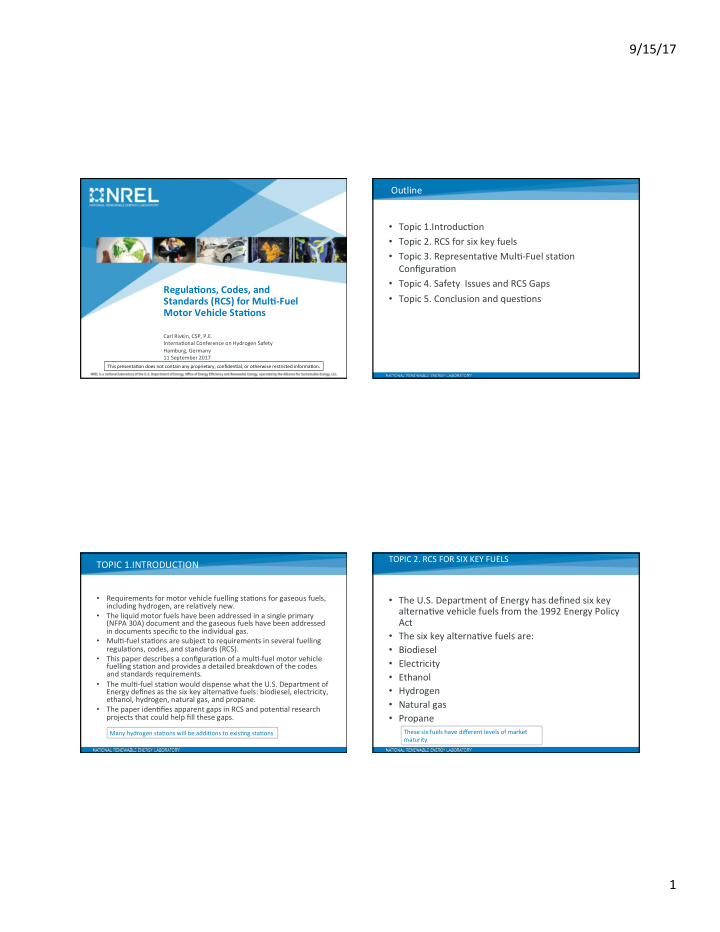



9/15/17 Outline • Topic 1.Introduc8on • Topic 2. RCS for six key fuels • Topic 3. Representa8ve Mul8-Fuel sta8on Configura8on • Topic 4. Safety Issues and RCS Gaps Regula'ons, Codes, and • Topic 5. Conclusion and ques8ons Standards (RCS) for Mul'-Fuel Motor Vehicle Sta'ons Carl Rivkin, CSP, P.E. Interna8onal Conference on Hydrogen Safety Hamburg, Germany 11 September 2017 This presenta8on does not contain any proprietary, confiden8al, or otherwise restricted informa8on. TOPIC 2. RCS FOR SIX KEY FUELS TOPIC 1.INTRODUCTION • Requirements for motor vehicle fuelling sta8ons for gaseous fuels, • The U.S. Department of Energy has defined six key including hydrogen, are rela8vely new. alterna8ve vehicle fuels from the 1992 Energy Policy • The liquid motor fuels have been addressed in a single primary Act (NFPA 30A) document and the gaseous fuels have been addressed in documents specific to the individual gas. • The six key alterna8ve fuels are: • Mul8-fuel sta8ons are subject to requirements in several fuelling • Biodiesel regula8ons, codes, and standards (RCS). • This paper describes a configura8on of a mul8-fuel motor vehicle • Electricity fuelling sta8on and provides a detailed breakdown of the codes and standards requirements. • Ethanol • The mul8-fuel sta8on would dispense what the U.S. Department of • Hydrogen Energy defines as the six key alterna8ve fuels: biodiesel, electricity, ethanol, hydrogen, natural gas, and propane. • Natural gas • The paper iden8fies apparent gaps in RCS and poten8al research • Propane projects that could help fill these gaps. These six fuels have different levels of market Many hydrogen sta8ons will be addi8ons to exis8ng sta8ons maturity 1
9/15/17 TOPIC 2. RCS FOR SIX KEY FUELS TOPIC 2. RCS ANALYSIS DONE FOR SIX KEY FUELS Example of one of the six tables of key Note hydrogen too small to requirements show on bar chart TOPIC 3. REPRESENTATIVE MULTI-FUEL STATION TOPIC 3. REPRESENTATIVE MULTI-FUEL STATION CONFIGURATION CONFIGURATION • Charging sta8ons located at parking spaces • Fuelling for five of the six key fuels; propane is not included Note that in US Note that currently because it is not typically dispensed at retail facili8es propane used vehicle charging is for mainly rural not typically done • Integrated control systems vehicles at conven8onal fueling sta8ons • Separa8on between fuel storage for different fuel types including below grade storage for liquid fuels and liquefied hydrogen • Defined electrically classified areas at dispensing and storage areas • Visual and audible alarms • Charging sta8ons for electric vehicles at convenience store parking spaces • Storage ven8ng and pressure relief systems • Vehicle loading egress 2
9/15/17 TOPIC 4. SAFETY ISSUES AND RCS GAPS TOPIC 4. SAFETY ISSUES AND RCS GAPS • Within the United States codes and standards there is a complete set of • Fire panels are not designed for the mul8ple signals that requirements that would allow the installa8on and opera8on of a mul8- would be produced by the mul8ple sensing devices required fuel retail sta8on. at facili8es storing and dispensing mul8ple fuels. • The number of documents, the mul8ple cross references within documents to other documents, as well as the cost of obtaining these • Blending fuels can create flammable atmospheres in tank documents represents a barrier to both project developer compliance and head space where they did not previously exist by changing code enforcement. the flammability range of the vapour accruing in the tank The codes and standards requirements for the different fuels reside in • several documents and the requirements of these documents are not fully head space. integrated. • Retrofifng of exis8ng facili8es to add new fuelling capability • E-stops (emergency sta8on shut-down stops) and other control creates many issues with bringing an out of compliance requirements are not integrated within the RCS (for example ini8a8ng an E-stop for hydrogen fuelling would not necessarily shut down all fuelling facility into review with current requirements. opera8ons conducted at a mul8-fuel sta8on). • When managing changes, the impacts of modifica8ons to one • Fuel storage and dispensing setback distances for one fuel can impinge on system need to be evaluated regarding their site wide those for another fuel, such as setback distances for hydrogen storage impinging on setbacks for CNG storage. impacts. TOPIC 5. CONCLUSION TOPIC 4. SAFETY ISSUES AND RCS GAPS • The gaps in RCS point to several poten8al research areas. These • Basic RCS exist for mul8-fuel sta8ons research areas include the following: • There are gaps in integra8on of these requirements o Sensors that can perform in a mul8-fuel environment o Sta8on layout analysis factoring in all of the various setback distances • Performing a comprehensive risk analysis involving to produce an op8mal use of space at a specific loca8on o Hazard analyses by component level nodes for mul8-fuel opera8on experts from different areas of the fuelling industry. and impacts of inten8onal and uninten8onal releases scenarios, including the safety impacts of rou8ne ven8ng opera8ons NREL has begun work in assembling these expert o Impacts of opera8ons of different fuels on safety aspects of other groups and plans to proceed with the fuels, such as rou8ne maintenance ac8vi8es for one fuel impac8ng safety for another fuel comprehensive risk analysis. o The safety impact of heavier-than-air fuels poten8ally migra8ng into below grade storage areas • Developing an integrated RCS compliance tool for o Mul8-fuel impacts on materials—for example, the combina8on of mul8-fuel sta8ons as the level of deployment of fuels degrading materials that are designed for use with a specified fuel or impac8ng materials at the sta8on not designed to withstand these fuels increase. the impact of that fuel. 3
9/15/17 Thank You and Ques8ons • Carl Rivkin, CSP, P.E. - Safety Research Team Lead carl.rivkin@nrel.gov This work is supported by the DOE EERE Fuel Cell Technology Office! 16 4
Recommend
More recommend